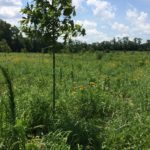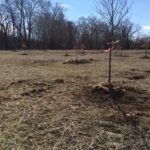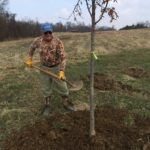By Chris Roshon, Natural Resources Manager

Settling in for a long winter’s nap, several hundred newly planted trees and shrubs stand in fields that not long ago were plowed by a previous owner. Tree planting with the goal of restoring valuable forest habitat to park lands has become an annual event for Preservation Parks staff and volunteers.
Since 2017, over 40,000 bare-root seedlings and 1,600 larger potted and balled and burlap plants have been planted on about 104 acres of former fields that are now park land. This future park is located on Bale Kenyon Road, motorists can see a few of the fields from I-71 just north of Polaris.
The larger plants are nice because they offer immediate visual impact, it’s easy to see that the area has been planted. We also plant seedlings by the thousands since obtaining a wider range of native species in this size is easier and they are less expensive to purchase, install, and maintain (no watering!).

I am often asked how tall a 6” seedling will grow after a few years. Some species grow a lot faster than others, for example sycamore and black locust can easily grow head-high in 5 years or less. Others such as oaks might be knee or waist high after 5 years if the soil conditions are good. The saying that “the best time to plant a tree was sometime in the past” certainly rings true to me.

Thank you to all the volunteers who have come out to help with the plantings, including those from local schools, scout groups, Earth Day participants, watershed groups, and park volunteers. We could not have completed so much work without support from the community. Their combined efforts will benefit a wide range of local wildlife, water quality, and park visitor experiences for many decades to come.







